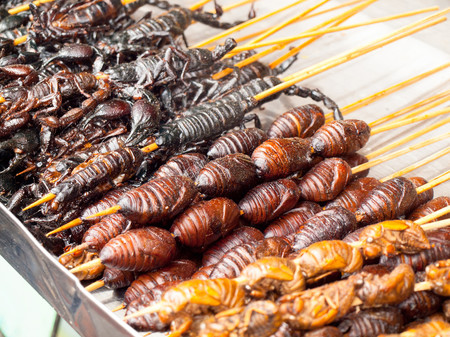Reese’s Cup Or Insects’ Cup?

Insects can be found in a lot of different foods and cooked in many ways.
October 28, 2019
It is very common to try new and exotic foods when traveling around the world. For instance, nobody can leave Thailand without snacking on very well fried, seasoned and crispy grasshoppers, crickets or woodworms. In fact, for most people, it is probably the first time they eat insects in their lives. Or at least they thought so.
Why would anyone cross an ocean and travel to the other side of the world when they can eat insects right where they live? Correction: when they are eating insects right where you live.
We all have this sweet moment temptation when we crave a Reese’s cup, some chocolate covered pretzels or a cinnamon roll. What we do not know, though, is that per 100 grams of chocolate, cinnamon and peanut butter, there is over 30, 60, maybe even 400 insect fragments and some rodent hairs, respectively, hiding inside according to the Food and Drug Administration (FDA).
There is no getaway. Even if you try to be healthy, over three percent of canned peaches are wormy or moldy while over 60 aphids, thrips and mites come with a portion of frozen broccoli.
This is what the FDA has established as Food Defect Action Levels in which “it is economically impractical to grow, harvest or process raw products that are totally free of non-hazardous, naturally occurring, unavoidable defects.”
In other words, we are stuck with insects and rodent hairs in our food as it seems to be completely unavoidable.
Everybody has somewhat of an idea that our food contains all these things that should not be there. However, it becomes eerily real when you read the numbers. Now the question is: how many mites have I ingested throughout my 21 years of life?
Although eating insects sounds terrible, at least for me, it has been reported to be nutritious.
“Insects form part of the traditional diets of at least 2 billion people,” according to studies by the Food and Agriculture Organization (FAO). For instance, termites are a main source of protein for Ghanaians and Chinese high-end restaurants serve roasted bee larvae.
Maybe they are not that bad after all.
The FAO explains that entomophagy, the consumption of insects, can be promoted for health, environmental and livelihood reasons.
“Insects are a highly nutritious and healthy food source with high fat, protein, vitamin, fibre and mineral content,” the report continued.
Along with some great health benefits, eating bugs and insects is financially more beneficial for large corporations as it requires less energy, food, water and time than animals to be ready for the market.
Maybe the phrase “one apple a day keeps the doctor away” should be “one grasshopper a day and all the world’s problems go away.”
Can you imagine walking into the university’s cafeteria and finding a selection of perfectly served seasoned beetles, caterpillars, bees, ants, grasshoppers and locusts instead of the burger grill, or how about going into Applebee’s late at night for their half-priced appetizers only to find crispy, fried barbecue crickets, cicadas, leafhoppers, termites and dragonflies instead of chicken wings on the menu?
It is all about the society and culture we have been born in. We do not look at insects the same way we look at pizza.
We run away from bees and yell when we see a cricket closer than two feet away. But if insects are actually good in all these different aspects, would you dare to start adding them to your everyday diet?










